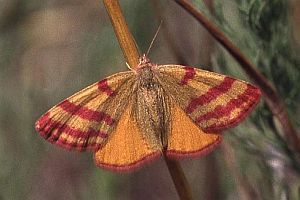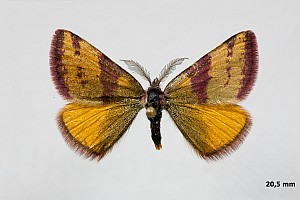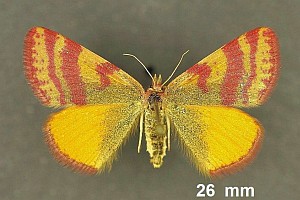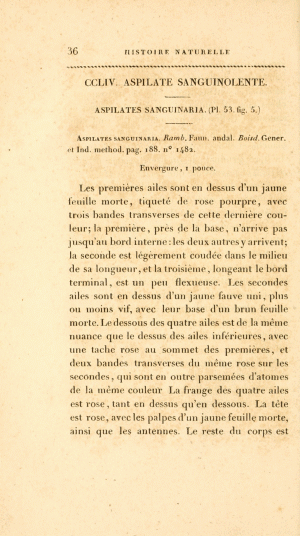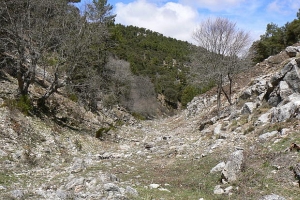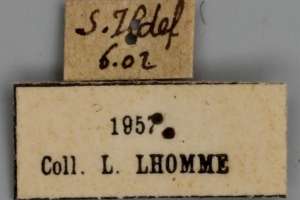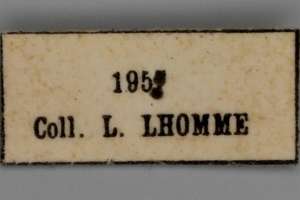1. Lebendfotos
1.1. Falter
2. Diagnose
2.1. Männchen
2.2. Weibchen
2.3. Erstbeschreibung
3. Biologie
3.1. Habitat
3.2. Nahrung der Raupe
Die Freiland-Raupennahrung ist strenggenommen noch unbekannt! King (2021: 95-92) berichtet aus seinen Erfahrungen mit der ex-ovo-Zucht der Art: "It is recorded on Rubia peregrina L. (Rubiaceae) (Millière, 1873; Mazel & Peslier, 1997) but has been reared on Rumex thyrsiflorus Fingerh. (Polygonaceae) (Gelbrecht in Hausmann & Viidalepp, 2012). King & Viejo Montesinos (2016) gave details on oviposition in comparison to strategies employed within the Sterrhinae. King (2014) provided data obtained from wild-caught females which included oviposition on Rumex acetosella L. (Polygonaceae) and its use as a food-plant." Es ist also davon auszugehen, dass die Art auch in der Natur Rumex thyrsiflorus, Rumex acetosella und vermutlich noch weitere Rumex-Arten nutzt, nicht aber den in eine völlig andere Verwandtschaft gehörenden Kletten-Krapp (Rubia peregrina).
(Autor: Erwin Rennwald)
4. Weitere Informationen
4.1. Etymologie (Namenserklärung)
„sanguinarius zum Blut gehörig, blutfarben.“
4.2. Andere Kombinationen
- Aspilates sanguinaria Duponchel, 1842 [Originalkombination]
4.3. Taxonomie
Die Lythriini galten bisher als Bestandteil der Unterfamilie Larentiinae, so auch noch in der Fauna Europaea (Fauna Europaea Web Service. Last update 22 December 2009. Version 2.1. Available online at [http://fauna.naturkundemuseum-berlin.de]). Nach einem Hinweis von A. Hausmann [Forum] sind sie aber zu den Sterrhinae zu stellen.
4.4. Faunistik
Nur von der iberischen Halbinsel und Südfrankreich bekannt.
4.5. Publikationsjahr der Erstbeschreibung
Woodward (1922: 380) [Digitalisat auf biodiversitylibrary.org] teilt die Publikationsjahre des Bandes mit: 1-112 (mit ?) und pl. 51-56 1842, 113-480 (mit ?) und pl. 57-72 1843, 481-[555] (mit ?) und pl. 73-80 1844, pl. 81-90 1845.
(Autor: Jürgen Rodeland)
4.6. Literatur
- Erstbeschreibung: Duponchel, P.-A.-J. (1842-[1845]): Histoire naturelle des lépidoptères ou papillons de France. Supplément aux tomes quatrième et suivants: 1-554, [555], pl. LI-XC. Paris (Méquignon-Marvis).
- King, G. E. (2021): Contribution to an understanding of the early stages of Lythria sanguinaria (Duponchel, 1842) (Lepidoptera: Geometridae: Sterrhinae) in Spain. — Boletín de la SAE 31: 95-105. [zum PDF-Download auf bp.blogspot.com]
- Woodward, B. B. (1922): Catalogue of the Books, Manuscripts, Maps and Drawings in the British Museum (Natural History). Vol. VI. Supplement: A–I: i-iv, 1-511, 1-48. London.




![Vorkommen in Frankreich (europäisches Territorium ohne Korsika) [Vandromme et al. (2020): Liste systématique et taxinomique des Lépidoptères de France]](/res/img/flag/fr.gif)
![Vorkommen in Spanien (Festland) [Vives Moreno A. (2014)]](/res/img/flag/es.gif)
![Vorkommen in Portugal (Festland) [Corley (2015): Lepidoptera of Continental Portugal]](/res/img/flag/pt.gif)
